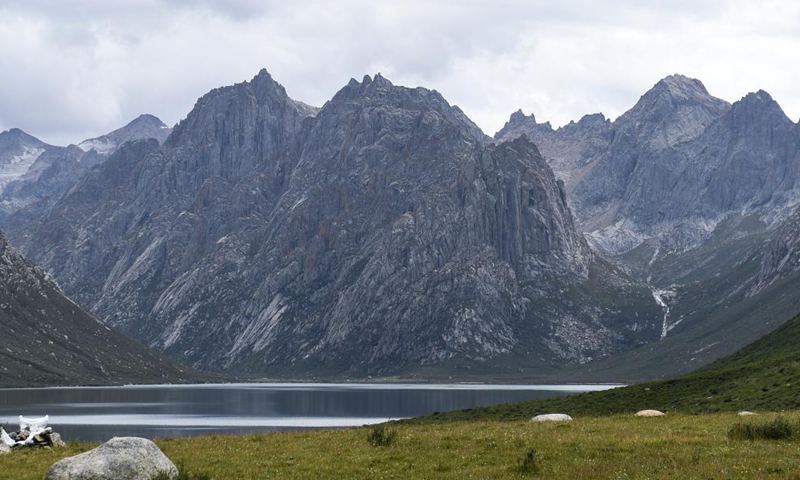
Photo taken on Aug. 25, 2021 shows a view of the Nianbaoyuze national geology park within the Sanjiangyuan (the Three-River-Source) national nature reserve in Jiuzhi County, Golog Tibetan Autonomous Prefecture, northwest China's Qinghai Province. Photo:Xinhua
China on Tuesday announced it would formally establish its first batch of five national parks, including the Sanjiangyuan (the Three-River-Source) National Park, the Wuyi Mountain National Park, the Giant Panda National Park, the Northeast China Tiger and Leopard National Park and the Hainan Tropical Rainforest National Park.
Addressing the leaders' summit of the 15th meeting of the Conference of the Parties to the Convention on Biological Diversity by video link, Chinese President Xi Jinping said that China is moving faster to establish a protected areas system with national parks as the mainstay. Xi noted that areas with the greatest importance to the natural ecosystem, and with the most unique natural landscapes, the most valuable natural heritage and the greatest biodiversity reserve will be included in the system.
The parks are among the 10 pilot national parks which have been reviewed by the country's authorities for national park status. Each of those parks hopes to protect the habitat of some endangered species.
The Giant Panda National Park holds 1,631 wild pandas, which accounts for more than 70 percent of the country's wild giant pandas, according to information the Global Times got from the National Forestry and Grassland Administration (NFGA).
Aside from the giant pandas, dubbed "the national treasures," the park is also home to highly protected animals, including the snub-nosed monkey.
Local governments have greatly contributed to protecting species in the park that stretches across Sichuan, Shaanxi and Gansu provinces. Sichuan has set up a biological court to review cases involving the illegal hunting and killing of key protected animals in the park. It also used high-tech methods, including infrared cameras, to monitor giant pandas.
National parks are China's calling card, and unlike nature reserves which protect specific species, national parks emphasize the protection of the entire ecosystem, Li Junsheng, a deputy director of the research center for eco-environmental science at the Chinese Research Academy of Environmental Sciences in Beijing, told Global Times on Tuesday.
Sanjiangyuan National Park is near the Giant Panda National Park. Located on the Qinghai-Tibet Plateau, Sanjiangyuan, known as the source of the Yangtze, Yellow and Lancang rivers, is home to hundreds of species of wild animals, many of which are under state protection, such as wild yaks, snow leopards, Tibetan antelopes and Tibetan gazelles.
Under the national park management, herders and farmers will be turned into the forces of environmental protection in the the Three-River-Source area. The work is expected to provide jobs, boost incomes and give people an incentive to protect the environment, said Xinhua.
At least 12 Siberian tiger cubs and 11 Amur leopard cubs have been born since 2017, when the Northeast China Tiger and Leopard National Park pilot project was launched in Northeast China's Jilin and Heilongjiang provinces, Xinhua reported on Sunday.

A still image from a video taken on May 10, 2018 by an infrared camera in Hunchun, Jilin Province shows a rare scene, a family of five wild Siberian tigers at the Northeast Tiger and Leopard National Park. (Photo provided to China News Service)
Populations of other wild animals, such as spotted deer and boars, are also on the rise, suggesting an improving eco-environment in the park that covers 1.46 million hectares.
Northeast China Tiger and Leopard National Park witnessed the largest numbers, and the most frequent activities of Seberian China tigers and leopard, said the NFGA.
The Wuyi Mountain National Park experimental area is the only one in China which is both a biosphere reserve and heritage site.
With a total of about 1,001 square kilometers, the park has about 210.7 square kilometers of primordial forest vegetation, preserving the world's largest subtropical primordial forest ecological system on the same latitude zone.

Aerial photo taken on Dec. 2, 2020 shows the mountains surrounded by cloud and mist in Wuyi Mountain National Park.(Photo: Xinhua)
Since the pilot program was launched in 2016, the ecological system of the Wuyi Mountain National Park has been protected, making it a successful example of a national park within a popular tourist region.
The Hainan Tropical Rainforest National Park occupies only 0.046 percent of the country's territory, yet it is home to almost 20 percent of the country's amphibians and 38.6 percent of China's birds.
The conservation of Hainan gibbons in China is a success story for biodiversity preservation worldwide. Hainan gibbon, the most endangered of all gibbons and the world's rarest primate, is endemic to the South China island. Its population has increased from as few as 7 to 9 in the 1980s to 35 today, according to a report released at the World Conservation Congress (WCC) in September.
The national park system aims to end the segmented management of a nature reserve that covers multiple provinces so that the integrity of wild animals' habitat can be guaranteed.
NFGA told the Global Times that the formal establishment of those national parks is just a start. In 2035, China will initially build a natural protected land system based on national parks.

China's first batch national parks Graphic: Feng Qingyin/GT

China's first batch national parks Graphic: Feng Qingyin/GT

China's first batch national parks Graphic: Feng Qingyin/GT

China's first batch national parks Graphic: Feng Qingyin/GT

China's first batch national parks Graphic: Feng Qingyin/GT




